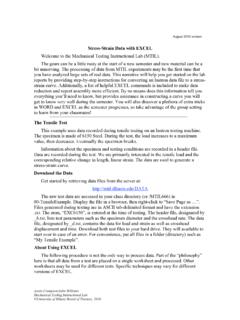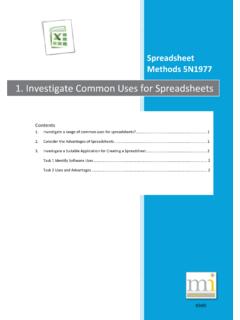Transcription of Stress-Strain Data with EXCEL - University of Illinois ...
1 Jessie Crompton/John Williams Mechanical Testing Instructional Lab University of Illinois Board of Trustees, 2010 August 2010 version Stress-Strain Data with EXCEL Welcome to the Mechanical Testing Instructional Lab (MTIL). The gears can be a little rusty at the start of a new semester and new material can be a bit unnerving. The processing of data from MTIL experiments may be the first time that you have analyzed large sets of real data. This narrative will help you get started on the lab reports by providing step-by-step instructions for converting an Instron data file to a Stress-Strain curve. Additionally, a list of helpful EXCEL commands is included to make data reduction and report assembly more efficient. By no means does this information tell you everything you ll need to know, but provides assistance in constructing a curve you will get to know very well during the semester.
2 You will also discover a plethora of extra tricks in WORD and EXCEL as the semester progresses, so take advantage of the group setting to learn from your classmates! The Tensile Test This example uses data recorded during tensile testing on an Instron testing machine. The specimen is made of 6150 Steel. During the test, the load increases to a maximum value, then decreases. Eventually the specimen breaks. Information about the specimen and testing conditions are recorded in a header file. Data are recorded during the test. We are primarily interested in the tensile load and the corresponding relative change in length, linear strain . The data are used to generate a Stress-Strain curve. Download the Data Get started by retrieving data files from the server at: The raw test data are accessed in your class directory (or /MTIL666) in 00-TensileExample.
3 Display the file in a browser, then right-click to Save Page as .. Files generated during testing are in ASCII tab-delimited format and have the extension .txt. The stem, EXC6150 , is entered at the time of testing. The header file, designated by , lists test parameters such as the specimen diameter and the crosshead rate. The data file, designated by , contains the data for load and strain as well as crosshead displacement and time. Download both test files to your hard drive. They will available to start over in case of an error. For convenience, put all files in a folder (directory) such as My Tensile Example . About Using EXCEL The following procedure is not the only way to process data. Part of the philosophy here is that all data from a test are placed on a single worksheet and processed.
4 Other worksheets may be used for different tests. Specific techniques may vary for different versions of EXCEL . Tensile Data analysis 2 Assistance is available by selecting Help on the menu bar. For more complete descriptions of engineering applications in EXCEL , see the references at the end. When using search engines, begin the entry with EXCEL , your platform and version. New workbook Open a blank workbook. Go to Sheet1. (See the tabs at bottom of the window). Be sure that the formula bar is displayed at the top of the screen. The formula bar has the cell address in the Name Box and its contents. (View>Formula Bar) In cell A1, type a title Tensile Example , press Enter. In A2, 6150 Steel . A title can help to locate a reference quickly when you are working with data from many tests.
5 Move to the title in the bottom tab, Sheet1 . Double click or right-click to rename the Worksheet as 6150 Example . In future assignments, you may want to analyze each material (or test) on a separate worksheet. Save your file. Helpful hint: Save your data periodically to a new filename. Keep the same basic stem, but progressively number as Steel6150 Tens# , Steel6150 Tens# , etc. If a major error is made, you can step back to a good saved version. Enter the header data. Highlight a cell in column A, a few rows down from the title. [Mouse over to the cell and click or move with the down arrow ( )]. (In the example, the cell is A4.) Go to your data directory and open the header file that you downloaded. Select ALL, and then Copy. Go back to EXCEL and paste these data into the worksheet.
6 Increase the width of column A to see full descriptions. (Double click on the border between the column headers, A and B . Column A will expand to display the widest entry in the column.) Enter the test data. On your worksheet in column A, highlight a cell that is a few rows down from the last line of the header file (A30 in the example). In your data directory, open the file, select ALL, copy, and paste into the worksheet. NOTE: the * is an indicator for some programs that the next row is a header row. Tensile Data analysis 3 A Note on Importing Data The files generated in the lab are tab-limited so that they easily paste into the worksheets. Importing data using Data>Get External Data> is not required. You should have something similar to: The EXCEL workbook containing a completed example is located in the HELP folder.
7 Formulas and References Relative and Absolute Formulas start with = . Remember that when a formula is copied, the cell addresses change. This is one of the most powerful features of spreadsheet programs. When the formula in C32, =A32 * B32 , is copied to cell C33, it becomes =A33 * B33 , and so on Tensile Data analysis 4 down the column. The value in column C is the product of the values in columns A and B in the same row. This task is an example of a relative reference; wherever the cell is copied, the result is the product of the values in the two cells to the left of it. Often, an operation is performed on many cells with a constant value. To compute engineering stress , the load in each row is divided by the original cross-sectional area. One method (not recommended) is to type the calculated area in the formula.
8 It is a better technique to use the address of the cell that contains the area data. To make a reference absolute (constant), place $ in front of the column and row. For the example above, =$A$32 * B32 copied to C33 results in =$A$32 * B33 . This feature may be used efficiently in our example. First compute the cross-sectional area and make the cell address a constant divisor in the formulas employing the $ designations. Another way to specify a constant is to name the cell. This is especially convenient when many different data sets are being analyzed. In the current sheet, locate Specimen diameter: in Column A (A12). Highlight the adjacent cell in column B (B12). From the menu bar (top of screen), choose Insert>Name>Define. EXCEL may suggest a name based on column A.
9 Since there may be more than one 6150 steel specimen, call this one Stl6150a and add diameter . Name: Stl6150a_diameter (highlighted); cell address = B12 in the current Sheet (bottom of the Define Name frame.) (Note: Names are not case sensitive.) Click OK. Note that the Name Box on the formula bar now displays the name rather than the column and row. Tensile Data analysis 5 Accessing the Define Name window is the only way to delete names and edit their ranges. Names may also be entered on the Formula Bar. The final diameter is displayed in cell B26. The formula bar displays the cell address in the Name Box and contents. Type the desired name in the Name Box and press Return. An entire range of cells may be highlighted and assigned a name in this manner.
10 Names and their ranges may not be edited using this technique. NOTE: Names must start with a letter or underscore, but may not be the same as a possible cell address. The most recent versions of EXCEL designate cell addresses using up to 3 letters and 7 digits, , abc1023456. Therefore, Stl6150 and Al2024 are invalid names. Some valid alternatives are Stl6150a , _Stl6150 , Steel6150 , Stl_6150 , and Al_2024 . Pi The constant, pi, is PI(). Note the empty parenthesis. A good technique is to enter functions in lower case. If the formula is correct, EXCEL converts it to caps. If not, it remains in lower case indicating an error. Area Arrow right ( ) to cell D12 and type in Area: . Set this label to align right with Format>Cells>Alignment, Horizontal: Right. In column E enter the formula for area, d2/4.









